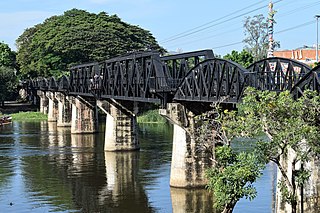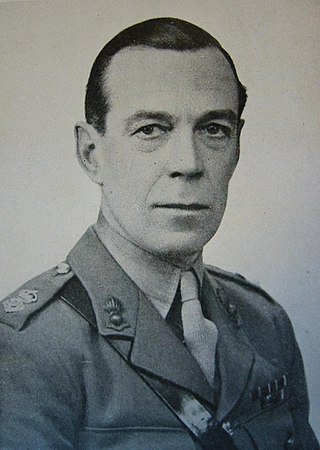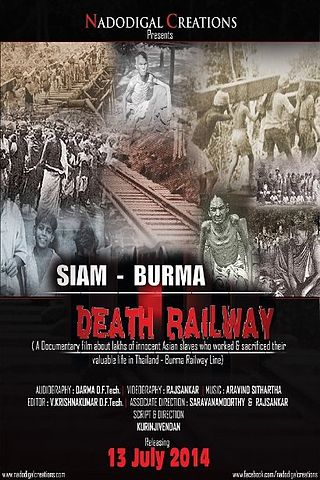
The Bridge on the River Kwai is a 1957 epic war film directed by David Lean and based on the 1952 novel written by Pierre Boulle.

The Burma Railway, also known as the Siam–Burma Railway, Thai–Burma Railway and similar names, or as the Death Railway, is a 415 km (258 mi) railway between Ban Pong, Thailand, and Thanbyuzayat, Burma. It was built from 1940 to 1943 by civilian laborers impressed or recruited by the Japanese and prisoners of war taken by the Japanese, to supply troops and weapons in the Burma campaign of World War II. It completed the rail link between Bangkok, Thailand, and Rangoon, Burma. The name used by the Japanese Government was Tai–Men Rensetsu Tetsudō (泰緬連接鉄道), which means Thailand-Burma-Link-Railway.

Kanchanaburi is a town municipality in the west of Thailand and part of Kanchanaburi Province. In 2006 it had a population of 31,327. That number was reduced to 25,651 in 2017. The town covers tambons Ban Nuea and Ban Tai and parts of Pak Phraek and Tha Makham, all of Mueang Kanchanaburi District, and parts of tambon Tha Lo of Tha Muang District. Kanchanaburi lies 123 km west of Bangkok.

Kanchanaburi is the largest of the western provinces (changwat) of Thailand. The neighboring provinces are Tak, Uthai Thani, Suphan Buri, Nakhon Pathom, and Ratchaburi. In the west it borders Kayin State, Mon State, and the Tanintharyi Region of Myanmar.

Quanzhou, alternatively known as Chinchew, is a prefecture-level port city on the north bank of the Jin River, beside the Taiwan Strait in southern Fujian, People's Republic of China. It is Fujian's largest most populous metropolitan region, with an area of 11,245 square kilometers (4,342 sq mi) and a population of 8,782,285 as of the 2020 census. Its built-up area is home to 6,669,711 inhabitants, encompassing the Licheng, Fengze, and Luojiang urban districts; Jinjiang, Nan'an, and Shishi cities; Hui'an County; and the Quanzhou District for Taiwanese Investment. Quanzhou was China's 12th-largest extended metropolitan area in 2010.

Three Pagodas Pass is a pass in the Tenasserim Hills on the border between Thailand and Myanmar (Burma), at an elevation of 282 metres (925 ft). The pass links the town of Sangkhla Buri in the north of Kanchanaburi Province, Thailand, to the town of Payathonsu in the south of Kayin State, Myanmar.

The River Kwai, more correctly Khwae Noi or Khwae Sai Yok, is a river in western Thailand. It rises to the east of the Salween in the north–south spine of the Bilauktaung range near, but not over the border with Burma. It begins at the confluence of Ranti, Songkalia and Bikhli Rivers. At Kanchanaburi it merges with the Khwae Yai River to form the Mae Klong River, which empties into the Gulf of Thailand at Samut Songkhram.

Mawlamyine, formerly Moulmein, is the fourth-largest city in Myanmar (Burma), 300 kilometres (190 mi) south east of Yangon and 70 kilometres (43 mi) south of Thaton, at the mouth of Thanlwin (Salween) River. Mawlamyine was an ancient city and the first capital of British Burma. The city is currently the capital and largest city of Mon State and the main trading centre and seaport in south eastern Myanmar.

Pakokku is the largest city in the Magway Region of Myanmar. It is situated about 30 km northeast of Bagan on the Irrawaddy River. It is the administration seat of Pakokku Township, Pakokku District and Gangaw District. Pakokku Bridge is part of the India–Myanmar–Thailand Trilateral Highway and is the longest bridge in Myanmar. It is home of the Pakokku Airport.

Brigadier Sir Philip John Denton Toosey was, as a lieutenant colonel, the senior Allied officer in the Japanese prisoner-of-war camp at Tha Maa Kham in Thailand during World War II. The men at this camp built Bridge 277 of the Burma Railway as later fictionalized in the book The Bridge over the River Kwai by Pierre Boulle, and since adapted into the Oscar-winning film The Bridge on the River Kwai in which Alec Guinness played the senior British officer, Lt Col Nicholson. Both the book and film outraged former prisoners because Toosey did not collaborate with the enemy, unlike the fictional Lt Col Nicholson.
Kyaukphyu is a major town in Rakhine State, in western Myanmar. It is located on the north western corner of Yanbye Island on Combermere Bay, and is 250 miles (400 km) north-west of Yangon. It is the principal town of Kyaukphyu Township and Kyaukphyu District. The town is situated on a superb natural harbor which connects the rice trade between Calcutta and Yangon. The estimated population in 1983 was 19,456 inhabitants. The population of Kyaukphyu's urban area is 20,866 as of 2014, while Kyaukphyu Township's population is 165,352.

The Bridge over the River Kwai is a novel by the French novelist Pierre Boulle, published in French in 1952 and English translation by Xan Fielding in 1954. The story is fictional but uses the construction of the Burma Railway, in 1942–1943, as its historical setting, and is partly based on Pierre Boulle's own life experience working in Malaysia rubber plantations and later working for allied forces in Singapore and Indochina during World War II. The novel deals with the plight of World War II British prisoners of war forced by the Imperial Japanese Army to build a bridge for the "Death Railway", so named because of the large number of prisoners and conscripts who died during its construction. The novel won France's Prix Sainte-Beuve in 1952.

Elder Dempster Lines was a UK shipping company that traded from 1932 to 2000, but had its origins in the mid-19th century.

Siam Burma Death Railway is a 2014 Singaporean documentary film written and directed by Kurinji Vendan about the Asian forced-laborers who worked on the Siam-Burma Death Railway during World War II.

Major Arthur Moon was an Australian army doctor who saved the lives of dozens of Far East prisoners of war as the Thailand-Burma Railway was being constructed during World War II.

Clifford Arthur Kinvig was senior lecturer in war studies at the Royal Military Academy, Sandhurst, director of education of the British Army, and a noted military author who debunked some of the myths about the bridge over the River Kwai and the construction of the Burma Railway.

The countries of the Bay of Bengal include littoral and landlocked countries in South Asia and Southeast Asia that depend on the bay for maritime usage. Historically, the Bay of Bengal has been a highway of transport, trade, and cultural exchange between diverse peoples encompassing the Indian subcontinent, Indochinese peninsula, and Malay Archipelago. Today, the Bay of Bengal region is the convergence of two major geopolitical blocs- the Association of Southeast Asian Nations (ASEAN) and the South Asian Association for Regional Cooperation (SAARC). The Bay of Bengal Initiative for Multisectoral Technical and Economic Cooperation (BIMSTEC) promotes regional engagement in the area.

Tamarkan was a Japanese prisoner of war work camp during World War II. The camp was initially used for the construction of the bridge over the Khwae Yai or Mae Klong River and not the River Kwai. The camp was located about five kilometres from the city of Kanchanaburi. In November 1943, Tamarkan was turned into a convalescent camp and hospital. By 1945, the camp was gone.

Nong Lu is a sub-district (tambon) of Sangkhla Buri district of Kanchanaburi province, Thailand. The name is Karen and refers to the palm used for roofing. It is located near the border with Myanmar. Nong Lu covers the main town of the district, which is often known by the district's name as Sangkhlaburi (สังขละบุรี); the municipality is officially known as Wangka (วังกะ).
Ayodeji Oladimeji Olukoju is a Nigerian University distinguished professor of history at the University of Lagos, Nigeria. He was a two-term vice chancellor of Caleb University, Imota between 2010 and 2016. Olukoju's research interests are in the area of maritime, transport, economic, social, corporate and urban history of Nigeria.


















